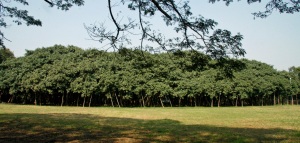Tree Liberation – Tales of the Mighty Brush Box
The brush box, Lophostemon confertus, is perhaps my favourite tree, not merely because of its beauty and strength, but because of the ways we got to know each other and the experiences we had together.
Our relationship began when I moved house at the age of 4 or 5. The tree at the front gate was easy to climb, its strong, smooth trunk curving over the sandstone wall at just the right height for clambering into. My sisters and I spent many important hours occupying its branches, our minds busy with games now forgotten. Christmas beetles, cicadas, bull ants and cupmoth caterpillars also inhabited that tree. These ‘hairy caterpillars’ are one of nature’s more bizarre creations, looking like a two-headed Chinese dragon in a colourful street festival. Their brightly patterned bodies with four bunches of orange stinging hairs at each end are a temptation to children, but a warning to wiser predators. ‘Don’t touch’ is the best invitation to a curious child, and so we were stung and became wary, but kept sharing the tree.

I don't have a pic of Brush Box just now, so here is the biggest tree of them all - the Great Banyan Tree, Botanical Gardens in Kolkata, India
There was another brush box, its trunk rising straight up from an old concrete slab that seemed to merge with the grey sandstone surrounds. We could not climb this tree, but its canopy was dense and its shade deep. It was always cool under there, for picnics, water fights, hand ball, bike riding, reading. Dad had a different relationship with these trees. They both grew up into the power lines that connected to the house.
Extension ladder in position, in his working bee overalls he would disappear into its dark greenery with various hand saws and pruners. Soon the branches came tumbling down, and our job was to drag them away. I had no idea then that this was a brush box. I had no idea then that it was planted under power lines all over Sydney and other Australian cities, where it was routinely mutilated by tree lopping teams. I had no idea then that it in its natural state it was a magnificent forest giant that yielded a superb smooth, pink timber which a few years later would spark controversy in the rainforests of NSW, spawning a debate and protest that ultimately led to World Heritage status for the rainforests of NSW.
“I WAS 16 WHEN I WENT TO MY FIRST LOGGING PROTEST. IT WAS AT TERANIA CREEK, A REMOTE END-OF-THE-ROAD LOCATION IN A LUSH SUBTROPICAL VALLEY IN NORTHERN NSW.”
I was 16 when I went to my first logging protest. It was at Terania Creek, a remote end-of-the-road location in a lush subtropical valley in northern NSW. I can’t remember how I ended up there, but suddenly I was camping in a paddock with a bunch of hippies. There were guitars and vegetarian food at a camp on the forest edge. The forest was rainforest, hung with vines and soft with the swaying elegance of Bangalow palms. Stands of brush box, the result of disturbance over a thousand years ago, led to a debate over what defined rainforest. The NSW Forestry Commission said rainforest did not contain hardwoods. The brush box is a hardwood, therefore this was not a rainforest and logging it should not be an issue. I stood on the freshly severed trunk of a tree that may have been 1,500 years old, surrounded by the devastation caused by its premature crash to earth, listening sadly to the chainsaws busy on another such tree of life. I knew then that the discussion about how to define a rainforest had little to do with reality, and that politics, whatever side you were on, was only a tool.
“ON MY RETURN TO THE CITY I MADE THE CONNECTION BETWEEN THESE FOREST GIANTS AND THE CREW-CUT STREET TREES WHICH I HAD BARELY NOTICED BEFORE.”
On my return to the city I made the connection between these forest giants and the crew-cut street trees which I had barely noticed before. These 35m trees were planted under power lines because they recovered well from pruning. Logical at some level I suppose, like the argument for logging them.
Some years later, as a horticulture student I made a study of rainforest regeneration. As a practical component I collected and propagated the seed of rainforest plants. The brush box was one, and as my forest of seedlings sprouted in the shade house there was no question about whether or not it was a rainforest species. It was in that year that the Wran Labour Government halted the logging of rainforests in NSW, nominating them for World Heritage listing. Terania Creek was part of that nomination, along with the surviving brush boxes, whose gorgeous timber had sparked the direct action movement that doggedly followed the log trucks and chainsaws until at last they were gone.
You can easily visit Protestor Falls in the Nightcap National Park, which includes Terania Ck. The sounds are of rushing water, bird song and the breeze in the canopy. But when I stand there, I still hear the chainsaws and the defiant songs of the activists whose courage is remembered in the naming of the waterfall, and who drew inspiration from the helplessness of the brush box, strongest of trees.